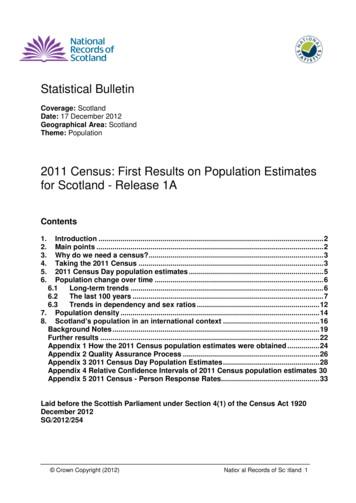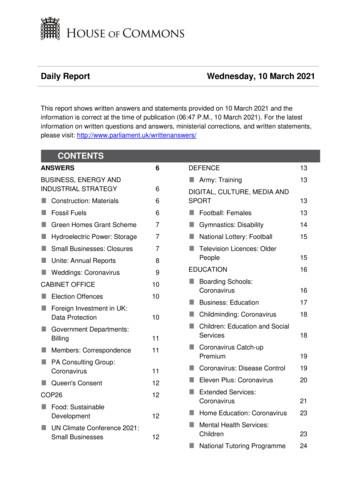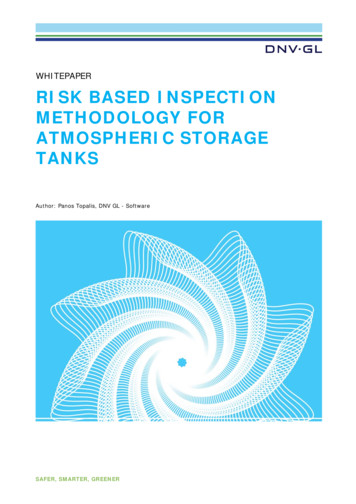Transport Scotland Statistical Bulletin
Key Reported Road Casualties Scotland 2016Transport ScotlandStatistical BulletinTransport Series14 June 2017Key Reported Road Casualties Scotland 2016This bulletin presents provisional statistics of reported injury road accidents (i.e. road accidentsreported to the police in which one or more people were killed or injured) in Scotland in 2016. Finalfigures will be published in October 2017.1.Main Points1.1There were a total of 10,881 road casualties reported in 2016 this is 93 or 1% fewer than 2015and the lowest number of casualties since records began in 1950. Of which there were: 191 fatalities: 23 (or 14%) more than 2015 - This updates National Indicator 32: “Reducedeaths on Scotland’s roads.” 1,693 seriously injured: 93 (or 6%) more than 2015 8,997 slightly injured: 209 (or 2%) fewer than 2015 [Table 2].1.2By mode, in 2016 there were: 6,683 car users injured (30, 0.4% less than 2015); including 106 fatalities (31 more than2015) 1,663 pedestrian casualties (32, 2% less than 2015); including 32 fatalities (12 less than2015) 711 motorcycle casualties (23, 3% less than 2015); including 30 fatalities (3 more than2015) 789 pedal cycle casualties (1% less than 2015); including 8 fatalities (3 more than 2015) 301 bus and coach user casualties (31, 9% less than 2015) [Table 3].These figures take no account of changes in modal choice so changes could be because moreor fewer people are travelling by a particular mode.1.3In 2016 there were 1,011 child casualties reported, 40 (4%) more than in 2015. This included12 fatalities, 8 more than last year [Table 4]. Conclusions on trend cannot be made from asingle year’s data as the numbers are small and fluctuate from year to year. Trends using athree year average are included in table 7.1.4In 2016 male fatalities rose by 10, 8% (to 134). Female fatalities rose by 13, 30% (to 57).Fifteen per cent (1,596) of all casualties were aged 16–22, a fall of 6% on 2015, of which 839were male and 757 were female. Casualties aged under 5 rose by 9%, from 141 to 154between 2015 and 2016 [Table 12].1.5Scotland’s road safety framework to 2020 contains 5 national targets for casualty reductionsby 2020 – a reduction compared to the 2004-2008 baseline has been achieved in each case: 191 people were killed in 2016, a reduction of 35% since the baseline (2020 target: 40%reduction) [Table 5] 1,693 people were seriously injured in 2016, a reduction of 35% since the baseline (2020target: 55% reduction) [Table 6] On average, there were 8 children killed each year between 2014 and 2016: a reduction of50% since the baseline (2020 target: 50% reduction) [Table 7] There were 167 children seriously injured in 2016: a reduction of 49% since the baseline(2020 target: 65% reduction) [Table 8] the 2016 slight casualty rate was 19.37 casualties per 100 million vehicle kilometres, areduction of 40% since the baseline (2020 target: 10% reduction) [Table 9].1
Key Reported Road Casualties Scotland 2016Transport ScotlandCONTENTSTopicPage1.Main points12.Background3Summary Infographic43.Reported numbers of Accidents54.Reported numbers of Casualties by Severity55.Casualties by Type of Road86.Casualties by Mode of Transport107.Child Casualties108.Progress towards the casualty reduction targets for 2020129.Accidents and Casualties by Police Force division and Local Authority area1810Casualties by gender and age2111.Source and definitions22Figure 1: Killed from 1950 - 2016Figure 2: Killed & seriously injured casualties and seriously injured casualties, 1950 - 2016Figure 3: All casualties and slightly injured casualties, 1950 - 2016Figure 4: Progress to casualty reduction target: Casualties killedFigure 5: Progress to casualty reduction target: Serious injured casualtiesFigure 6: Progress to casualty reduction target: Children killedFigure 7: Progress to casualty reduction target: Children seriously injuredTable 1: Injury road accidents by severityTable 2: Casualties by severityTable 3: Casualties by built-up and non built-up roads, mode of transport and severityTable 4: Child casualties by built-up and non built-up roads, mode of transport and severityTable 5: People killed by mode of transportTable 6: People seriously injured by mode of transportTable 7: Children killed by mode of transportTable 8: Children seriously injured by mode of transportTable 9: Slight casualties by mode of transportTable 10: Accidents by police force division, council and severityTable 11: Casualties by police force division, council and severityTable 12: Casualties by gender, severity and age, 2004 - 20162
Key Reported Road Casualties Scotland 2016Transport Scotland2.Background2.1This bulletin presents provisional statistics of reported injury road accidents(i.e. road accidents in which one or more people were killed or injured) in Scotlandin 2016. These figures were extracted from Transport Scotland's reported road accidentstatistical database (based on ‘Stats19’ statistical returns made by police forces) on 19May 2017. Final 2016 figures will appear in Reported Road Casualties Scotland 2016 ,which will be published in October 2017 and may differ slightly due to late returns andamendments. For similar reasons, the figures given here for 2015 and earlier years maydiffer slightly from those published previously. Further information about the differencesbetween the main figures in the publications can be found in section 11.2.2.2The statistics are the numbers of injury road accidents which were reported by thepolice. Each accident is classified according to the severity of its most seriously injuredcasualty. Very few, if any, fatal accidents do not become known to the police. However,there could be many non-fatal injury accidents which are not reported by the public to thepolice, and are therefore not counted in these statistics because the police can only reportaccidents of which they are aware. An article on under counting in the statistics is includedin Reported Road Casualties Scotland 20102.3The Scottish Road Safety Framework published on 15 June 2009, outlined Scotlandspecific road safety targets. The casualty reduction targets for 2020 are described insection 11.5. Progress towards them is covered in section 8, figures 4 to 7 and tables 5 to9.2.4Key Reported Road Casualties Scotland 2016 is one of a series of TransportStatistics publications. A comprehensive statistical picture of transport activity is given inthe compendium Scottish Transport Statistics volume and the latest transport and traveltrends from Scottish Household Survey transport data published in Transport and Travelin Scotland. Key Reported Road Casualties Scotland 2016 is followed in October byReported Road Casualties Scotland, a volume which includes extensive analyses of thenumbers of accidents, vehicles and casualties. See Transport Scotland statisticalpublications for more details:2.5We welcome comments and feedback on these statistics. Any comments can beaddressed to us using the contact details below.Prepared for publication by:Richard MorrisonAndrew KnightCharlie LewisTransport Analytical ServicesTransport ScotlandVictoria QuayEdinburgh EH6 6QQTelephone: 0131 244 7256Email: transtat@transport.gov.scot3
KeySummary:Reported Road Casualties Scotland 2016InfographicTransport Scotland2016 Road Accidents And Casualties10,881Road casualties in relation to 2020 targets:road accident casualties in Scotland in 20161%fewer than theprevious yearActual %change in 2016casualties from2004-08averageKilled-35%191-35%more than theprevious year-50%-49%6%moreNote: Data for 2016 are provisional-43%-55%-35%-50%-50%-65%2%fewerThere were more people killed or seriouslyinjured on built-up roads (roads with a speedlimit of 40 mph or less), however, proportionally,casualties on non built-up roads were moresevere1% killedRoad accident casualties by mode of transport:Number ofCasualties2016-40%Children serious8,997 people recorded asslightly injured in road accidentsIn 2016, 209 fewer than in 2015-30%Children killed1,693 people recorded asseriously injured in roadaccidents in 2016, 93 more thanin 2015Casualtyreductiontarget for2020SeriousPeople were killed in road accidents14%Casualtyreductionmilestone for201513% serious3% killed19%serious% change incasualties since20156,6830%1,663-2%711-3%789-1%Built-up roadsNon-built-uproadsFor web publication and furtherinformation, visithttp://bit.ly/KRRCS4
Key Reported Road Casualties Scotland 2016Transport Scotland3.Reported numbers of Accidents (Table 1)3.1 Table 1 shows the downward trend of injury road accidents recorded by the police.In 2016, there were 8,346 accidents in which someone was killed or injured, 2 per centfewer than in 2015 and the lowest number since records began. There were 175 fatalaccidents in 2016, eighteen (11%) more than in 2015. In 2016, there were 1,428 seriousinjury accidents - an increase of 8 (1%) on 2015; and 6,743 slight injury accidents reportedin 2016, 2 per cent (160) fewer than 2015.Table 1: Injury Road Accidents by Severity, 1970 – 9,7778,9888,8418,4808,346Reported numbers of Casualties (Table 2)4.1In 2016, 191 people were killed in road accidents in Scotland: 23 (14%) more than2015 . Since 1978, there has been a clear, steady long-term downward trend. More recentyears' figures have fluctuated around a less pronounced downward trend [Figure 1].4.2In 2016 there were 1,693 people seriously injured in road accidents: 93 (6%) morethan in 2015. The long-term trend, has generally been downward since the early 1980s[Figure 2].4.3There were 8,997 people reported as slightly injured in 2016 which was 209 (2%)fewer than in 2015. Between 1970 and the late 1990s, the figures fluctuated between17,000 and 21,000. However, there has been a clear downward trend since 1997 [Figure3].5
Key Reported Road Casualties Scotland 2016Transport ScotlandTable 2: Casualties by Severity, 1950 – 0201120122013201420152016prov.2004 - 2008 average2012 - 2016 average2016 percentage change:on 2015on 04-08 average1. Figures for 2015 and earlier years may differ slightly to those previously published due to late returns, or corrections to earlier returns.2. Although regular records of the numbers of casualties began in 1947, the level of severity was only collected from 1950 and thenumber of injury road accidents weren’t collected until 1970.4.4There were a total of 10,881 casualties (of all severities) reported in 2016: 93 (1%)fewer than in 2015 and the lowest number since records began in 1950. Between around1970 and 1990, the figures fluctuated around a general downward trend, with numbersfalling from the short-term peak in 1989 & 1990 (of over 27,000). Since 1998, there hasbeen a consistent reduction every year, with numbers falling below 12,000 in 2013 whichwas half the level of the early 1990s [Figure 3].6
Key Reported Road Casualties Scotland 2016Transport ScotlandFigure 661964Number of casualties killed, 1950 to 030020010001950Figure 1:Killed & Seriously injured casualties andSeriously injured casualties, 1950 - 201612,00010,0008,0006,0004,0002,000Killed & Seriously injured casualties7Seriously injured 7019681966196419621960195819561954195219500
Key Reported Road Casualties Scotland 2016Transport ScotlandFigure 3:All casualties and Slightly injured casualties, 1950 - 201635,00030,00025,00020,00015,00010,0005,000All tly injured casualtiesCasualties by Type of Road (Table 3)5.1In 2016, non built-up roads (roads with a speed limit of over 40mph, seeparagraph 11.4 for more detail) accounted for two-fifths of the total number of reportedcasualties (40%: 4,308 out of 10,881). However, they accounted for just over threequarters of those killed (77%: 147 out of 191) and half of the total number of seriouslyinjured (50%: 839 out of 1,693). This will be at least in part due to the higher averagespeed as non built-up roads are those with a speed limit of greater than 40 mph. Theseroads also make up two thirds of Scotland’s road network.5.2Compared with the 2004-08 average, there has been a greater reduction incasualties on non built-up roads (40%) than built-up roads (33%). The reduction in built-uproads fatalities was greater at 47% than non built-up at 30%. There was a 35% reductionin those seriously injured for both built-up and non built-up roads.8
Key Reported Road Casualties Scotland 2016Transport ScotlandTable 3: Casualties by built-up and non built-up roads, mode of transport andseverity, 2014-2016 & 2004-08 averageMode ofTransportPedestrian2004-08 average201420152016 prov.% change on 2015on 04-08 averagePedal cycle2004-08 average201420152016 prov.% change on 2015on 04-08 averageMotor cycle2004-08 average201420152016 prov.% change on 2015on 04-08 averageBuilt-up roadsKilled SeriousNon built-up roadsKilled SeriousAllAllKilledAll 30810,97410,881-1%-36%Car2004-08 average201420152016 prov.% change on 2015on 04-08 averageBus/Coach2004-08 average201420152016 prov.% change on 2015on 04-08 averageOther modes of transport2004-08 average201420152016 prov.% change on 2015on 04-08 averageAll casualties2004-08 average201420152016 prov.% change on 2015on 04-08 average123Figures for 2015 and earlier years may differ slightly to those previously published due to latereturns, or corrections to earlier returns.* indicates that a percentage change is not shown because the denominator is 50 or fewer.There are two cases where the speed limit is unknown.9
Key Reported Road Casualties Scotland 2016Transport Scotland6.Casualties by Mode of Transport (Table 3)6.1Figures on numbers of casualties by mode should be compared with data on mode usesince changes could be due to more or fewer people travelling by a particular mode. Informationon mode use is published in the road traffic or personal travel sections of Scottish TransportStatistics (STS). Department for Transport (DfT) traffic estimates in STS showed that car trafficincreased by 3% and motorcycle/moped traffic volume decreased by 1% between 2011 and 2015.Over the same period cycling volumes increased by 12%. Latest Scottish data by mode covers2015, data for 2016 will be published in August 2017 in Transport and Travel in Scotland 2016.6.2In 2016 there were 6,683 car users reported injured in road accidents; three fifths of allcasualties (61%: 6,683 out of 10,881) and a 0.4% fall on 2015. Of these, 106 were killed and 758seriously injured (increases of 41% and 19% on 2015 respectively). Non built-up roads accountedfor half of all car user casualties (50%: 3,349 out of 6,683) but a much higher percentage of caruser fatalities (92%: 98 out of 106) and those seriously injured (73%: 553 out of 758). Again likelydue in part to higher average speeds on these types of roads.6.3There were 1,663 pedestrian casualties recorded in 2016, a sixth of all casualties (15%:1,663 out of 10,881) and down by 32 (2%) since 2015. Two per cent of pedestrian casualties werekilled (32 out of 1,663) and 24% seriously injured (397 out of 1,663). 96% of pedestrian casualtiesoccurred on built-up roads (1,600 out of 1,663). 44% of pedestrian casualties on non built-up roadswere killed or seriously injured (28 out of 63) compared with 25% on built-up roads (401 out of1,600).6.4Together, all other modes of transport accounted for a quarter (23%) of casualties in2016 (2,535 out of 10,881), for a slightly higher proportion of those killed (28%: 53 out of 191) anda third of those seriously injured (32%: 538 out of 1,693).6.5Motorcycle and pedal cycle casualty numbers in 2016 decreased by 3% and 1%respectively. In 2016, 711 motorcycle casualties were reported, of whom 268 (38% and anincrease of 4% on 2015) suffered serious injuries, 30 died, an increase of three on 2015. Therewere 789 pedal cyclist casualties recorded in 2016, 147 (19% and a decrease of 10% on 2015)were seriously injured and 8 died (three more than in 2015).There are now more cyclists on theroads which will likely impact on cycling casualty numbers. There was an increase of 41% in pedalcycle traffic in the last ten years, as shown by the DfT traffic estimates published in ScottishTransport Statistics6.6A total of 301 bus and coach users were reported injured (a decrease of 9% on 2015), ofwhom 42 (7 less than 2015) were seriously injured, three died.7.Child Casualties (Table 4)7.1There were 1,011 child casualties reported in 2016 representing 9% of all casualties(1,011 out of 10,881) and an increase of 40 (or 4%) on 2015. Of these, 167 were seriously injuredand 12 died, 8 more deaths than in 2015. Seven of the twelve children killed in 2016 were in a
Transport Scotland. Statistical Bulletin . Transport Series . 14 June 2017 . Key Reported Road Casualties Scotland 2016 . This bulletin presents . provisional. statistics of reported injury road accidents (i.e. road accidents reported to the police in which one or File Size: 627KB
Statistical Bulletin Coverage: Scotland Date: 17 December 2012 Geographical Area: Scotland . This bulletin presents the first results from the 2011 Census in Scotland, which was held . transport and health. Decisions are taken every day using c
Accessible Travel Annual Delivery Plan 2021-22 Transport Scotland 4 Finally, I would like to take this opportunity to pay particular thanks to the Mobility and Access Committee for Scotland (MACS), Disability Equality Scotland (DES) and all the members of our Accessible Travel Steering Group. All of whom have
British Transport Police (BTP) By Jennifer Brown Contents: 1. Policing. 2. The British Transport Police . Statistical Bulletin 2017/18, section three . integrating the BTP in Scotland with Police Scotland. 5 Commons Library Briefing, 14 May 2019 . 1. Policing The British Transport Police (BT
On electronic versions if you click the legislation name it will link to the law. 1. Social Work (Scotland) Act 1968 2. Mental Health (Scotland) Act 2015 3. National Health Service and Community Care Act 1990 4. Community Care and Health (Scotland) Act 2002 5. Regulation of Care (Scotland) Act 2001 6. Public Services Reform (Scotland) Act 2010 7.
FOOD STANDARDS SCOTLAND Interventions Food Law Code of Practice (Scotland) Laid before the Scottish Parliament pursuant to section 40(1) of the Act1, regulation 24(1) of the Food Hygiene (Scotland) Regulations 20062 and regulation 6(1) of the Official Feed and Food Controls (Scotland) Regulations 20093 1 1990 CHAPTER 16 2 SSI 2006 No. 3 3 SSI 2009 No. 446
environment, Education, Housing, Health, Transport, Leisure & Recreation and Social Justice amongst other areas. Patient Transport In November 2018, Disability Equality Scotland ran a weekly poll of its members on the topic of patient transport and access to transport for healthcare and medical appointments.
Mar 10, 2021 · SCOTLAND 94 Arts: Scotland 94 . UN Climate Conference 2021: Scotland 96 SPEAKER'S COMMITTEE ON THE ELECTORAL COMMISSION 96 Electoral Register 96 TRANSPORT 97 Airport and Ground Operations Support Scheme 97 . UK statistical bulletin. Unite: Annual Reports John Spellar: [163630] To ask th
initially created for the AST committee of API and later encouraged by the RBI committee of API. The initial scope was mainly tank floor thinning. The methodology was later extended to include a quantitative method for shell thinning, as well as susceptibility analysis (supplement analysis) for shell brittle fracture and cracking. Figure 2 shows a typical process plant hierarchy and the AST .























